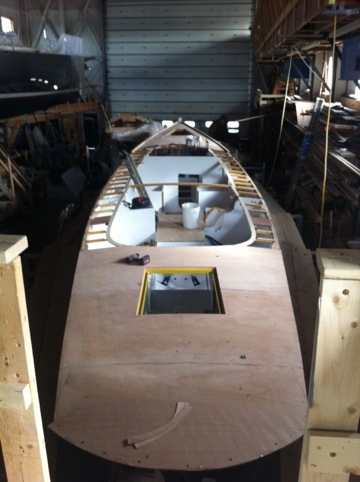With the deck frame and plywood subdeck nearly laid on the 47′ sloop Lark, it’s time to start marking out the pieces that make up the deck’s visible layer, which will be teak. This blog is a follow-up to my preious blog
. . . sign up to the right to get immediate access to this full post,
plus you'll get 10 of our best videos for free.
Get Free Videos& Learn More Join Now!!for Full Access Members Sign In



David Klein says:
Hello Eric, thanks so much for going all the way to the end for me! I am getting ready to put down the teak on my wife’s 1962 55′ Chris Craft Constellation. I smile because it’s only mine when there is work to do,,,which is often of late! In the process of pricing Teak, the question of “Old Growth Teak” from India versus “Plantation Grown Teak” from Indonesia or South America has come up. What is your experience with these two materials (or any others that might be out there) as it pertains to laying down, longevity, etc.?
David Klein says:
Eric? Your thoughts?
Eric Blake says:
Sorry David this one slipped past me. In general plantation grown lumber is grown very quickly making it not as dense, having very wide growth rings. The beauty of a teak deck is that it requires no finish in that they are usually left bare. Plantation grown teak will move dimensionally much more than old growth and could lead to bungs popping and caulking failure which is the down fall of so many decks. My opinion is that you get what you pay for. While the price difference between the two is significant, the labor involved in laying a teak deck and maintaining it for a lifetime is a larger percentage of the project. This is not to say that there isn’t some good plantation grown teak out there. You really want to compare the growth rings per inch of any wood you buy. Hardware store dimensional lumber is a good example of plantation quality, for structural work it is pretty crap. Teak such as this is fine for brightwork and interior trim but if I were laying a teak deck on my own boat I would get the best stuffI could find in hopes of never having to do it again.
Hope this helps,
Best, Eric
David Klein says:
Thanks Eric! Do you have a “growth rings per inch” recommendation you could make?
David Klein says:
I read that teak pulls silica up from the ground which is what gives it the “non-skid” quality. Also, the oils in the wood (I’m assuming) give it longer life. Do you know if the plantation teak compromises these qualities and is something I should try to measure?
Victor Lee Fox says:
Hello Eric
Thanks for the photos and dialogue on how to build a light but very strong traditional looking deck. Your tip on doing the king plank last so the details cuts can be perfect was great. What kind of 1/4 inch marine grade underlay was used? Okoume? Sapele? or Meranti/Keruing Mahogany (Hydroteck) ? Lark is going to be a lovely vessel when she is finished and ready to set sail.
Lee
Rockland, ME
Eric Blake says:
Thanks for your note Lee. The plywood used is 1/4″ Okoume. We chose it for its light weight and high strength. Best, Eric
Geoff Kerr says:
Mylar for transferring patterns is one of the great mystical secrets of boatbuilding. The confidence it inspires is as valuable as the reversability. Most decent art supply stores carry it by the sheet, often in two versions…rough on one side or two. As my local store is twenty mile away I routinely find myself rotating a sheet 90 degrees and superimposing another pattern on the same sheet for a nautical palimpsest. Label carefully and keep colored pencils handy!
Eric Blake says:
I recently lofted the transom for my small yawl boat on a mylar with a curved radiused transom lofted on it from years ago. My eyes started to cross after a bit but it was good exercise for them. Mylar is handy to have around for all sorts of things. Hope to see you soon Geoff. I am itching for a sail on Ned Ludd !!